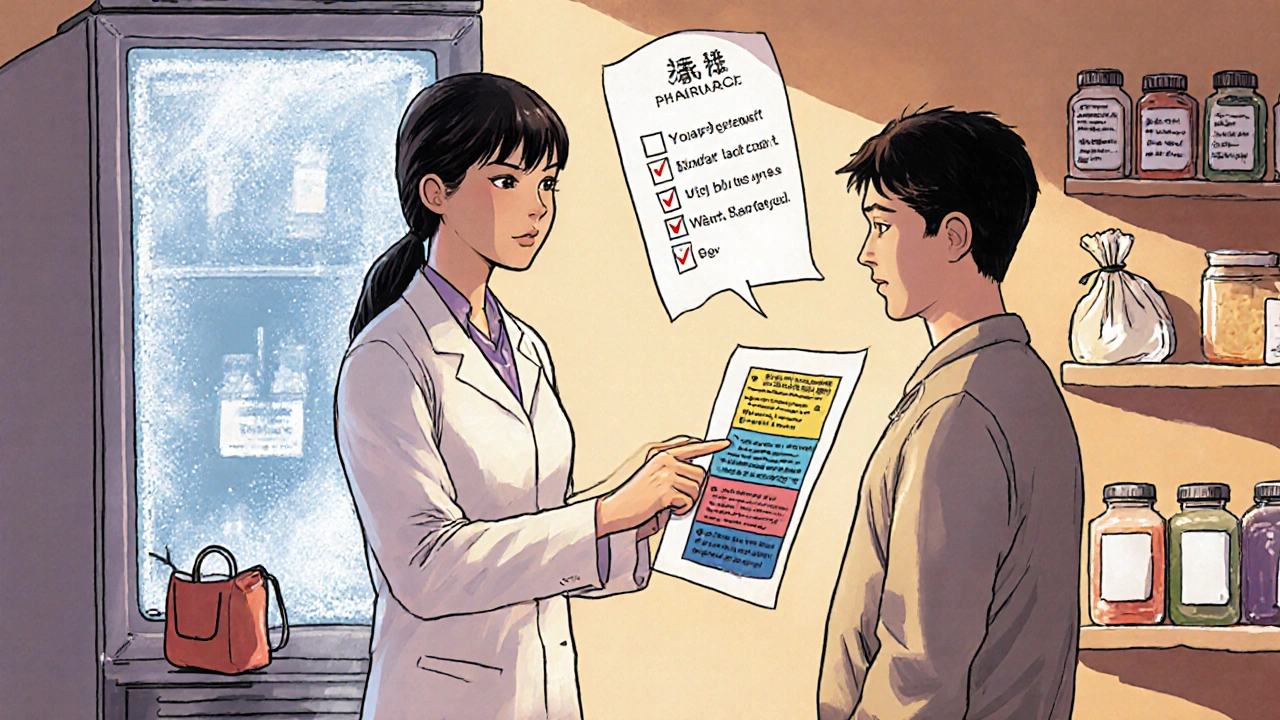Proper Storage and Handling Guide for Halobetasol Products
 Oct, 21 2025
Oct, 21 2025
Halobetasol Storage Condition Checker
Check if your storage conditions meet the FDA and USP guidelines for halobetasol stability. Input your specific conditions to get immediate feedback on product integrity.
Halobetasol is a high‑potency topical corticosteroid used to treat psoriasis, eczema, and other inflammatory skin conditions. When you’re handed a tube of cream or a jar of ointment, the last thing on your mind is whether the drug will stay effective until the patient finishes it. Yet a single lapse in halobetasol storage can reduce potency, raise the risk of side‑effects, or even render the medication unsafe. This guide walks you through the exact steps you need to keep every halobetasol product stable from the pharmacy shelf to the patient’s bathroom.
Why Proper Storage Matters
Halobetasol belongs to the class of Topical corticosteroid that are highly sensitive to temperature, light, and humidity. In the wrong environment the active ingredient can degrade, leading to a loss of up to 30% of its anti‑inflammatory power within six months. A weakened product may fail to clear a psoriasis flare, prompting patients to misuse the medication or request higher‑strength repeats. Moreover, degraded steroids can produce irritating by‑products that cause burning, itching, or secondary infections. For pharmacies, the financial impact of discarded stock adds up quickly-especially when bulk containers are involved.
Understanding Halobetasol Formulations
Halobetasol is marketed in three main forms: cream (0.05%), ointment (0.05%), and lotion (0.05%). Each base has a different excipient matrix, which influences how the drug reacts to heat and light. Creams contain water‑in‑oil emulsions that are more prone to separation in high humidity, while ointments use a petroleum‑based vehicle that resists moisture but can soften at temperatures above 30 °C. Lotions are alcohol‑based and evaporate quickly, making them the most temperature‑sensitive of the trio. Knowing these nuances lets you tailor storage recommendations to the exact product your pharmacy carries.
Recommended Storage Conditions
The FDA and USP USP <797> set clear parameters for non‑sterile pharmaceutical storage. For halobetasol, follow these baseline rules:
- Temperature: Keep between 20 °C and 25 °C (68 °F‑77 °F). Do not exceed 30 °C (86 °F) for more than 24 hours.
- Relative Humidity: Maintain 30%-60% RH. Avoid damp basements or areas with condensation.
- Light Exposure: Store in opaque or amber‑colored containers. Direct sunlight or fluorescent UV can accelerate degradation.
- Airflow: Ensure good ventilation; avoid sealed cabinets that can trap heat.
Below is a quick reference table that summarises the ideal conditions for each formulation.
| Formulation | Optimal Temp. | Max Temp. | Humidity Range | Special Note |
|---|---|---|---|---|
| Cream (0.05%) | 20‑25 °C | 30 °C (short‑term) | 30%‑55% RH | Keep lid tightly closed to prevent water ingress. |
| Ointment (0.05%) | 20‑25 °C | 32 °C (short‑term) | 30%‑60% RH | Petr‑based base resists moisture; focus on temperature. |
| Lotion (0.05%) | 20‑24 °C | 28 °C (short‑term) | 30%‑50% RH | Alcohol evaporates quickly; avoid warm delivery trucks. |

Handling Procedures for Pharmacy Staff
Once the product arrives at the pharmacy, follow a strict chain of custody:
- Inspect the shipment: Look for broken seals, leaked containers, or condensation inside the packaging.
- Log temperature: Record the ambient temperature at receipt. If it exceeds 25 °C, place the product in a climate‑controlled area within two hours.
- Separate bulk from patient‑ready stock: Keep large containers in a dedicated, temperature‑monitored cabinet; smaller tubes belong on the dispensing shelf.
- Label with “Use By” dates: Halobetasol’s shelf life is typically 24 months from manufacture, but once opened a single tube should be used within 30 days and then discarded.
- Educate the patient: Explain how to store the medication at home, emphasizing a cool, dry place away from children’s reach.
These steps align with best practices outlined by the FDA’s “Guidance for Industry: Stability Testing of New Drug Substances and Products.”
Special Situations: Compounding, Travel, and Bulk Storage
Compounded halobetasol creams often involve custom bases, which can shift the stability profile. For a Compounding pharmacy, conduct a mini‑stability study: store a sample at 4 °C, 25 °C, and 40 °C for 30 days and test potency weekly. If the concentration drops more than 5%, adjust the preservative system or recommend a different base.
Patients travelling abroad should be advised to pack halobetasol in insulated carriers if the destination’s climate exceeds 30 °C. Portable cooling packs that stay below 25 °C for 12 hours are sufficient for a week’s supply.
For bulk storage (e.g., a 500 g jar used in a dermatology clinic), a dedicated refrigerated unit set at 4 °C ± 2 °C is ideal. Periodically rotate stock using a “first‑expire, first‑out” (FEFO) method to avoid waste.

Common Pitfalls and How to Avoid Them
Even seasoned pharmacists slip up. Here are the three most frequent errors and quick fixes:
- Leaving containers in direct sunlight: Place a small UV‑filtering film on refrigerator doors or store the product on a lower shelf.
- Mixing different batches: Keep batch numbers separate; mixing can hide a degraded lot and complicate recalls.
- Using expired or partially used tubes: Implement a visual cue-like a colored sticker-once a tube passes the 30‑day mark after opening.
Quick Checklist for Daily Use
- Check storage temperature twice daily.
- Inspect lids and seals before dispensing.
- Record lot number and expiry on the dispensing label.
- Provide patients with a one‑page handout on home storage.
- Schedule quarterly audits of bulk halobetasol inventory.
Frequently Asked Questions
Can I store halobetasol in a standard pharmacy refrigerator?
Yes, but only if the refrigerator maintains a stable 4 °C ± 2 °C. Avoid placing the product near the freezer section, where temperature spikes can occur.
What happens if a patient stores the cream in a hot bathroom?
Extreme heat can break down the active steroid, reducing its effectiveness and potentially causing skin irritation. Advise the patient to move the product to a cooler drawer.
Is it safe to use a halobetasol tube that’s been open for 45 days?
No. Once opened, the tube should be discarded after 30 days to prevent microbial growth and potency loss.
Do I need a special license to dispense halobetasol?
In the UK, halobetasol is a prescription‑only medicine (POM). You must have a valid prescription from a qualified prescriber before dispensing.
How can I verify that my stock hasn’t degraded?
Perform a potency assay using high‑performance liquid chromatography (HPLC) at least annually, or when you suspect temperature excursions.
By following these storage and handling practices, you’ll keep halobetasol products effective, safe, and ready for the patients who depend on them.

Ericka Suarez
October 21, 2025 AT 16:25Storing halobetasol wrong is a total disaster for our great nation!
Brandy Eichberger
October 22, 2025 AT 14:38What a meticulously crafted guide! The depth of detail on temperature thresholds and humidity ranges really showcases a level of professionalism that many overlook.
Eli Soler Caralt
October 23, 2025 AT 12:52One might even argue that the very act of preserving a potent steroid mirrors the human quest for stability in a chaotic world 🌌. Yet, the practical steps-like avoiding sunlit cabinets-remain the anchor that keeps our therapeutic aspirations from drifting into oblivion. 📚
Eryn Wells
October 24, 2025 AT 13:52Hey everyone! 🌟 Let’s remember that proper storage isn’t just a technical requirement; it’s a way of showing respect for each patient’s journey and cultural background.
Kathrynne Krause
October 25, 2025 AT 14:52Absolutely! By turning those storage tips into a vibrant, colourful infographic, we empower patients from every walk of life to keep their treatment effective and safe.
Chirag Muthoo
October 26, 2025 AT 14:52It is advisable to document the receipt temperature of each shipment in a controlled logbook and to implement a corrective action if deviations exceed the specified thresholds.
Angela Koulouris
October 27, 2025 AT 15:52Great point, Chirag. Maintaining a clear log not only satisfies regulatory compliance but also builds confidence among staff that every tube is handled with care.
Harry Bhullar
October 28, 2025 AT 16:52Proper storage of halobetasol begins the moment the container leaves the manufacturing line.
The first checkpoint is the temperature of the delivery truck, which should be monitored with calibrated data loggers.
If the ambient temperature exceeds twenty‑five degrees Celsius, the product must be transferred immediately to a climate‑controlled area.
Next, the pharmacy should assign a dedicated shelf that is insulated from both heat sources and direct sunlight.
Light exposure, especially ultraviolet, can catalyze degradation pathways that diminish anti‑inflammatory potency.
Therefore, storing the cream in amber‑tinted containers or behind UV‑filtering film is highly recommended.
Humidity control is equally critical; a relative humidity above sixty percent can cause phase separation in cream formulations.
Ointments, while more resistant to moisture, are susceptible to softening when temperatures rise above thirty degrees Celsius.
Lot numbers and expiration dates must be clearly printed on each dispensing label to avoid accidental usage of expired stock.
Pharmacy technicians should perform a visual inspection of seals and lids before each dispense to catch any compromise.
For bulk containers, a dedicated refrigerated unit set at four degrees Celsius plus or minus two degrees provides an extra safety margin.
Regular audits, ideally on a quarterly basis, help identify temperature excursions before they affect product integrity.
When patients receive the medication, they should be instructed to store it in a cool, dry drawer away from bathroom heat and child access.
Providing a one‑page handout with simple icons for temperature and humidity can dramatically improve home compliance.
Finally, any suspected degradation should prompt a potency assay using HPLC to confirm that the active ingredient remains within acceptable limits.
Dana Yonce
October 29, 2025 AT 17:52Got it! 👍 Keeping it cool and checking the label is super easy.
Lolita Gaela
October 30, 2025 AT 18:52From a pharmacokinetic stability standpoint, maintaining the product within the ICH Q1A(R2) recommended chamber conditions mitigates accelerated degradation kinetics and preserves the AUC of the active moiety.
Giusto Madison
October 31, 2025 AT 19:52Exactly, Lolita-if you ignore those chamber specs, you’re basically inviting variability that could compromise therapeutic outcomes, and that’s just unacceptable.
erica fenty
November 1, 2025 AT 20:52Indeed; compliance is non‑negotiable!!!